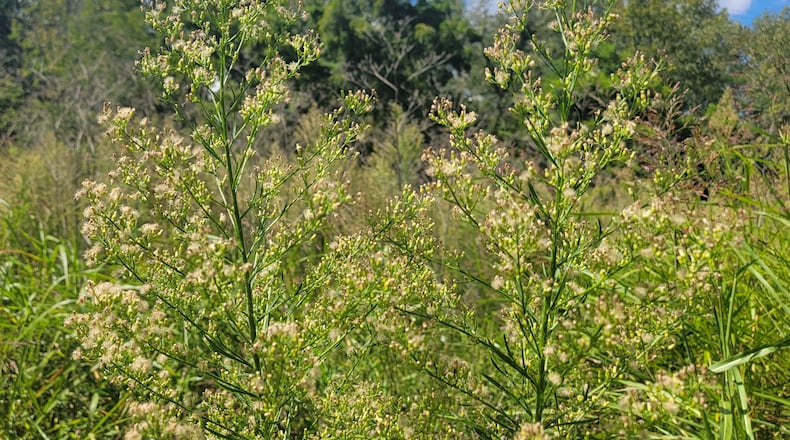Marestail or Conyza canadensis is also known as horseweed. It gets its name from the flower head that looks like the end of a horse’s tail. The problem with this weed is that it is completely resistant to glyphosate and other agricultural herbicides.
This winter annual comes up either in the fall or early spring. It first emerges as a rosette. A rosette is a plant that has a circular structure of leaf growth close to the ground.
The flowering stalks shoot up in the summer and can get to around six feet tall. I know this for a fact as I was removing some of them taller than me at five feet, three inches!
The leaves are singularly attached directly to the stem, sort of in a whorl around the stem. The leaves are smaller in size the higher they are on the stem.
The flowers emerge in late summer (now), bloom, and go to seed. The flowers are small and white, sort of like a daisy, and insignificant. However, one plant can produce up to 200,000 seeds that are easily distributed by the wind. This is significant!
The seeds can easily blow into your flowerbeds and gardens from nearby fields, farms, and ditches. Once established, you have work ahead of you to eradicate the population.
Unfortunately, I have let my beds go this summer and the Marestail is catching up with me. I can’t spray it because sprays for the homeowner are ineffective. Therefore, I spent extensive time this week pulling every single plant that I could find.
They are easy to pull if the ground is slightly moist. If it’s dry and you break off the stem and don’t get the roots, you will have more Marestail in the future.
I compost almost everything on my property, but this is one weed that doesn’t go into the compost pile. Homeowners can’t get high enough temperatures in a compost pile to kill the seeds.
Get it out now before it goes to seed. This is my mantra for all weeds, even though sometimes I can’t keep up with them. This summer has been particularly challenging for me due to my schedule.
Another option for controlling Marestail is to use a preemergent herbicide to prevent any seeds from germinating this fall or next spring. This is my next level of attack, followed by a layer of mulch to hopefully smother any emerging seedlings.
According to research, Marestail seeds only survive around three years in the soil so this is very helpful. If you can prevent flowers from going to seed this year and follow up with removal, mulch, and herbicides to prevent more from germinating, you might win the battle.
Unfortunately, if you live in an area where Marestails are present elsewhere in the neighborhood, the war will continue.
Pamela Corle-Bennett is the state master gardener volunteer coordinator and horticulture educator for Ohio State University Extension. Contact her by email at bennett.27@osu.edu.
Credit: Contributed
Credit: Contributed
About the Author


